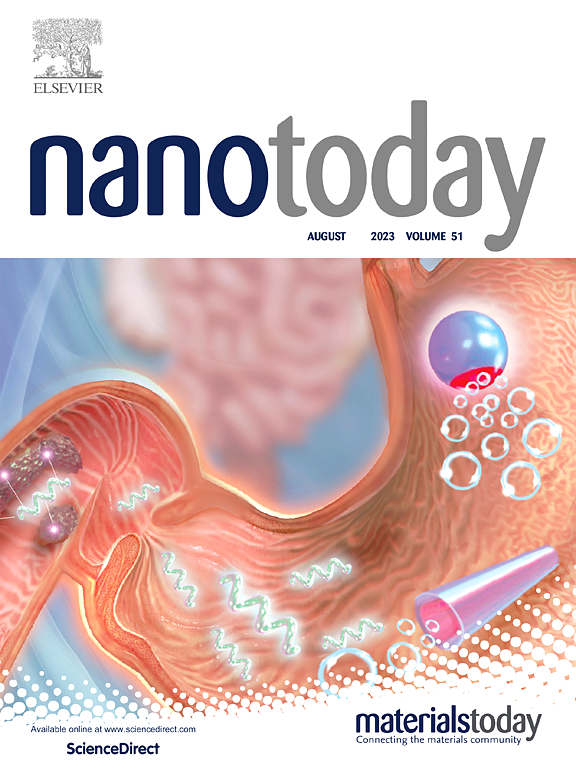具有微环境适应性和有序输送H2S和bFGF的可生物降解多模态生物材料用于脊髓损伤的治疗
IF 10.9
1区 材料科学
Q1 CHEMISTRY, MULTIDISCIPLINARY
引用次数: 0
摘要
脊髓损伤是一个复杂的、相互作用的过程,涉及多个病理阶段。单一类型的生物材料往往难以快速适应不平衡的再生微环境,难以有序解决不同阶段的症状,导致神经再生缓慢,功能恢复有限。在此,我们开发了一种微环境自适应和时间自适应的多模态生物材料(定制设计的丝素蛋白水凝胶- sf和内源性刺激响应nanomedicine-G@Mn, SF-G@Mn)用于治疗脊髓损伤。SF-G@Mn以脊髓损伤后的病理信号为基础,通过异步释放动力学实现继发性脊髓损伤早期和晚期不同需求下抑制微环境调节药物(H2S和Mn2 +)和神经再生药物(碱性成纤维细胞生长因子(bFGF))的精准释放。在炎症、氧化应激和缺氧的早期阶段,Mn2+可以不断分解H2O2生成氧气,与H2S协同作用,共同缓解氧化应激、改善缺氧、抑制炎症,从而全面调节不利于组织修复的微环境。随着损伤进展到以神经再生为主的后期,bFGF被缓慢释放以支持轴突生长和髓鞘再生,帮助恢复受损神经的功能。经过这种多维、有序、多阶段的治疗,脊髓损伤小鼠的运动功能得到了明显的恢复。总的来说,本工作提供了病理信号响应,在不同病理阶段按需、有序地释放药物的多模态生物材料,实现时空选择性和适应性治疗,为未来个性化医疗的发展提供了有价值的范例。本文章由计算机程序翻译,如有差异,请以英文原文为准。
Biodegradable multimodal biomaterials with microenvironmental adaptability and orderly delivery of H2S and bFGF for the treatment of spinal cord injury
Spinal cord injury (SCI) is a complex and interactive process involving multiple pathological stages. Single-type biomaterials often struggle to rapidly adapt to the imbalanced regenerative microenvironment and orderly resolve the symptoms of different stages, resulting in slow neural regeneration and limited functional recovery. Herein, we developed a microenvironment- adaptive and time-adaptive multimodal biomaterial (custom-designed with silk fibroin hydrogel-SF and endogenous stimulus responsive nanomedicine-G@Mn, SF-G@Mn) for the treatment of SCI. Based on pathological signals after SCI, the SF-G@Mn achieves the precise release of drugs that inhibit microenvironment regulation (H2S and Mn2 +) and nerve regeneration drugs (basic fibroblast growth factor (bFGF)) under different needs in the early and late stages of secondary SCI through asynchronous release kinetics. In the early stages of inflammation, oxidative stress and hypoxia, Mn2+ can continuously decompose H2O2 to generate oxygen, and synergistic effects with H2S can jointly relieve oxidative stress, improve hypoxia and inhibit inflammation, thus comprehensively adjusting the microenvironment that is not conducive to tissue repair. As the injury progresses to a later stage dominated by nerve regeneration, bFGF is slowly released to support axon growth and myelin regeneration, helping to restore the function of the damaged nerve. After this multi-dimensional, orderly and multi-stage treatment, the motor function of the SCI mice was significantly restored. In general, this work provides a pathological signal response, on-demand, orderly release of multi-modal biomaterials of drugs at different pathological stages, to achieve spatio-temporal selectivity and adaptive treatment, and provides a valuable example for the development of personalized medicine in the future.
求助全文
通过发布文献求助,成功后即可免费获取论文全文。
去求助
来源期刊

Nano Today
工程技术-材料科学:综合
CiteScore
21.50
自引率
3.40%
发文量
305
审稿时长
40 days
期刊介绍:
Nano Today is a journal dedicated to publishing influential and innovative work in the field of nanoscience and technology. It covers a wide range of subject areas including biomaterials, materials chemistry, materials science, chemistry, bioengineering, biochemistry, genetics and molecular biology, engineering, and nanotechnology. The journal considers articles that inform readers about the latest research, breakthroughs, and topical issues in these fields. It provides comprehensive coverage through a mixture of peer-reviewed articles, research news, and information on key developments. Nano Today is abstracted and indexed in Science Citation Index, Ei Compendex, Embase, Scopus, and INSPEC.
 求助内容:
求助内容: 应助结果提醒方式:
应助结果提醒方式:


